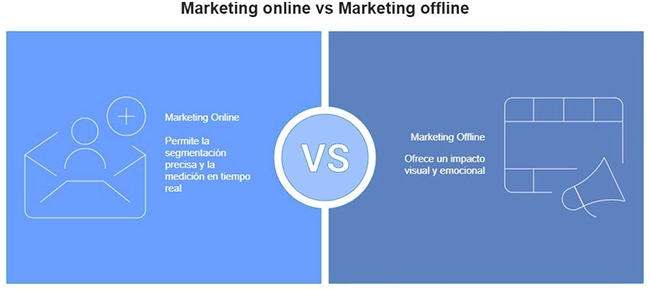Online and offline marketing are two essential strategic approaches in the promotion of products and services. Each has its own particularities and brings different benefits to companies, so it is important to know them well independently. In addition, having this information will make it easier to know how they can work if they join forces.
If you stay with us, below you will learn what each type of marketing is, their differences, benefits and how to combine them to maximize results.
In short, this is what you will find in this article:
- Definition of online marketing. Concept and examples.
- Definition of offline marketing. What this strategy consists of and where it is applied.
- Main differences between both types of marketing. How they differ according to the type of channel, reach, segmentation and results, among others.
- Advantages of online and offline marketing. Specific benefits of each approach.
- Examples of online and offline marketing. Integrated campaigns as a way to combine them.
- How to carry out an online and offline marketing strategy. From the initial analysis and the setting of objectives, to the choice of the appropriate tools.
Discover how our direct and promotional marketing service can help you attract customers, build customer loyalty and differentiate yourself with multichannel campaigns.
What is online marketing?
Online marketing refers to all those strategies and promotional actions carried out on the Internet. It includes tactics such as SEO positioning, advertising on social networks, email marketing, email email marketing, SMS marketing and pay-per-click (PPC) campaigns. This type of marketing allows reaching global audiences in an immediate and highly segmented way.
What is offline marketing?
Offline marketing, on the other hand, encompasses all promotional strategies that take place outside the digital realm. This includes offline advertising techniques such as TV commercials, radio, billboards, flyers and face-to-face events.
Despite the rise of the digital world, offline marketing, with all its practical examples, is still relevant, especially in sectors where physical contact and local presence are essential.
Given their definitions, do you want to delve deeper into their differences? Read on to find out the details

Differences between online and offline marketing
Although the goal of both types of marketing is to attract and retain customers, there are clear differences between them. Here are some of the most common ones.
Communication channels
The channels used for offline and online communications differ. Online marketing uses digital channels such as social media, search engines, emails and websites. Offline marketing uses offline media such as print newspapers and magazines, television, radio, postal mail and outdoor advertising.
If you are not yet familiar with this channel, here we explain what direct marketing is and why it is still so effective.
Scope and segmentation
Another issue that differentiates offline and online advertising is reach and targeting.
With online marketing, it is possible to reach global audiences and segment them precisely, thanks to advanced analytics tools. This facilitates direct marketing. In contrast, offline marketing tends to focus on local or regional audiences, with broader and less specific segmentations.
Costs and performance measurement
In general terms, online marketing can be more cost-effective and allows you to measure results accurately, thanks to analytical platforms such as Google Analytics.
On the other hand, offline marketing actions tend to be more expensive and their impact measurement is more complex, although they are still effective in campaigns with a high visual or emotional impact.
Having clarified their differences, let’s now look at the key benefits of online and offline marketing. Read on if you want to discover them.
Benefits of offline and online marketing
Online and offline marketing have their unique benefits that can complement a company’s strategies.
Advantages of online marketing
Among the advantages of online marketing are:
- Tight segmentation. It allows you to reach specific audiences based on demographics, interests and behaviors.
- Personalized marketing. Through the use of data, companies can create messages tailored to each customer.
- Immediate interaction. Consumers can respond, interact or make purchases in real time.
- Flexibility and speed. Campaigns can be quickly adjusted according to the results obtained.
Advantages of offline marketing
The advantages of offline marketing campaigns include:
- Tangible presence. Materials such as brochures, cards or billboards have a physical presence that reinforces the message. They are also the best option when you want to impact an audience that you don’t have access to digitally, such as senior citizens.
- Greater emotional impact. TV commercials or live events tend to generate more intense emotions.
- Local connection. An offline marketing strategy is ideal for reaching specific audiences in specific geographic areas.
Once the advantages of each type of marketing are understood, how can they be applied? What’s more, how can they be applied together? We give you the key below.
Online and offline marketing examples and strategies
Online and offline marketing strategies can be even more effective when combined, as integrated campaigns can take advantage of the best of both worlds.
Integrated campaigns: combination of online and offline
When developing multichannel multichannel marketing strategies are developed, effective combinations emerge. A simple example: imagine an insurance company that uses offline advertising (billboards) to attract customers to its physical offices, while using online marketing (social media campaigns) to drive traffic to its website.
This approach, which brings together offline and online communications, improves the customer experience and increases the chances of conversion. But how do you map out an effective strategy?

How to create an online and offline marketing strategy
Designing an online and offline marketing strategy requires planning, especially when seeking to integrate both techniques. These are the basic steps.
Analysis and objectives
The first step is to analyze the target audience, the market and the available resources. From there, set clear objectives for the online and offline campaign.
Online and offline marketing plan
A well-structured online and offline marketing plan details the specific tactics, channels to be used and budgets allocated for each type of campaign.
Tools and technologies
There are technological tools that facilitate the integration of both strategies, such as multichannel marketing automation platforms. These allow you to manage and automate offline and online communications, improving the efficiency and consistency of messages.
When it comes to directing online and offline marketing strategies, having the support of experts can greatly boost the success of any campaign.
Solutions for marketing communications marketing communications solutions from MailComms Group solutions allow you to manage your company’s multichannel direct marketing and promotional communications in a comprehensive and automated way.
This means superior effectiveness in your communication during all phases of your customers’ life cycle: from customer acquisition to customer loyalty.
Interested in learning more? contact MailComms Group and we will answer your questions!
Frequently Asked Questions
What is the difference between online and offline marketing?
The main difference between online and offline marketing lies in the channels used. Online marketing is done through digital media, while offline marketing uses traditional media such as television, radio and the press.
What are examples of online and offline advertising?
In the digital realm, for example, there are ads on social networks and Google Ads, and in the physical realm, there are billboards or radio ads.
How to combine online and offline marketing campaigns?
To combine an online and offline campaign, it is essential to maintain consistency in the message and use tools that allow the integration of both strategies, such as multichannel marketing platforms.
What media are used in offline and online communication?
Online and offline media include everything from social networks, blogs, newsletters and emails, to newspapers, brochures, television and billboards.
What are the advantages of an offline marketing strategy?
The main advantages of an offline marketing strategy are its emotional impact, local connection and the ability to build customer trust.
